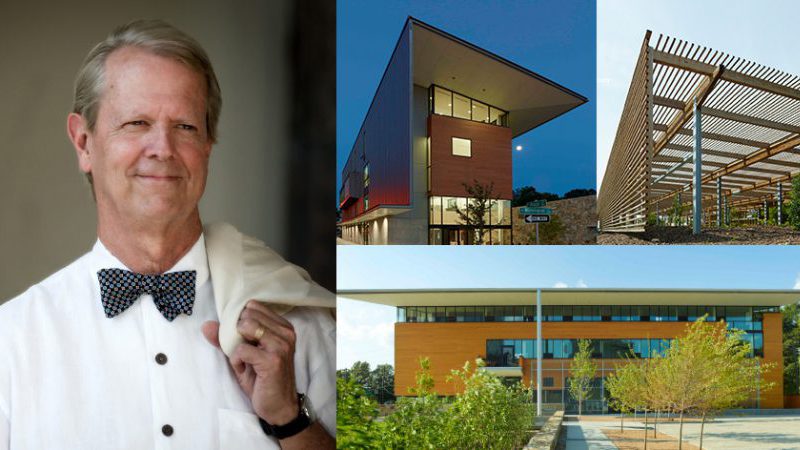Frank Harmon: Architecture As a Way of Life

Architecture is ultimately an expression of our society, and the more I can facilitate that and become, in a sense, invisible in my work – so that it seems to belong to its place and the people who use it – the happier I’m going to be.
Frank Harmon is an inspiration to young architects across the state and a pillar of creativity in the Raleigh community. His pages of credentials and awards range from wood design to sustainability and his projects, from private residences to major museums. At this stage in his career, Harmon is opting for more transparency as a way to create harmony in his work.“I think architecture is ultimately an expression of our society, and the more I can facilitate that and become, in a sense, invisible in my work – so that it seems to belong to its place and the people who use it – the happier I’m going to be.” Harmon said.
Harmon studied at the College of Design for two years before going to London to finish his architecture degree at the Architectural Association School of Architecture. During that time, the climate of North Carolina was still predominantly agricultural. “I came to NC State in 1960, and at that time, the School of Design was just about the only design/artistic game in town in North Carolina. It was a very special place. It was, in a sense, a stand-alone institution.” Harmon said.
After graduating and working in New York and London for a couple years, Harmon could have started his own firm in Atlanta or San Francisco, where architecture and art were booming. He knew that in those cities, he would have been a little fish in a big pond. Instead, Harmon decided to head back home to practice, where he would be a big fish in a little pond, creating waves of inspiration and standing proudly as a North Carolina architect.
Early in his practice, Harmon needed time to develop his style and niche. His roots played a large part in honing and embracing that. “Somewhere along the line after 10-15 years of experience, I think as architects, we start to look to our inner voice.” Harmon said. “I think my inner voice comes from my childhood and growing up around the forest and creeks of Greensboro, North Carolina. And now looking back on it, most of what I know about architecture I learned by the time I was eight years old, fishing for crawfish and watching birds build nests along the riverbank and knowing the difference in how the water flowed between one season and the next. Those earliest memories I’ve always tried to build on in my work.”
Harmon has been a professor of practice at the College since 1981 and has always considered himself an architect as well as a teacher. His appreciation for the impact of his upbringing has permeated his teaching goals and shaped the way he approaches the educational experience with his students. “My primary goal with my students is to get them to trust themselves and who they are and it’s very hard to do. We all start out learning from other designers and we tend to think these other designers get their inspiration, perhaps, straight from Heaven. But one of my roles in teaching is to introduce designers, architects, to my students and to get the students to understand that these are people. Every architect had a childhood, every architect went to school, every architect had mentors, every architect grew up in a certain way that shaped his or her life and work. So one of my goals is to empower my students to respect their background, from Elkin or Okracoke, as a great source of design,” he says.
At this juncture in his career, when Harmon has collected just about every architectural award imaginable, one might wonder if there is anything left that he could possibly want to add to his legacy in North Carolina architecture. Harmon responds reflectively: “At this stage in life, I’m more interested in buildings that draw people together and create a sense of community than I am doing buildings that stand out and are unique. I’m more interested in being the architect that facilitates a gathering or way of life than I am in creating a monument, and I think that’s natural as one gets older.”
A few months ago, Harmon boarded the USS North Carolina to receive the F. Carter Williams Gold Medal, the highest honor the North Carolina Chapter of the American Institute of Architects [ AIA NC] bestows on an architect, as well as four other prestigious awards for projects his firm designed. In his nomination letter for Harmon, fellow architect Jeffrey Lee, FAIA, principal of Clark Nexsen, stated: “Across the architectural profession, Frank Harmon, FAIA, is the face of North Carolina architecture. Through his words, his deeds, and the work of his firm, he has brought to a national audience a glimpse of the unique character and architectural culture of his home state. Frank cares about how his buildings enhance the lives of those who use them. He cares about how they are crafted and detailed. He cares about how they tread softly upon their sites, and he cares deeply about the contribution his buildings make to the architectural legacy of North Carolina.”
We couldn’t have said it any better.
- Categories:


